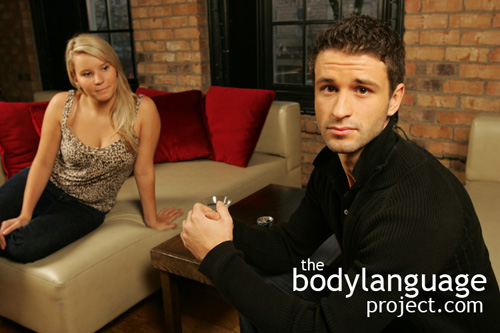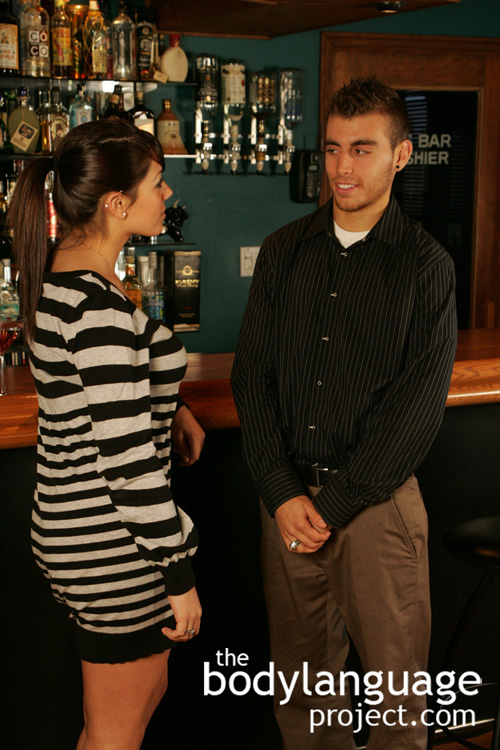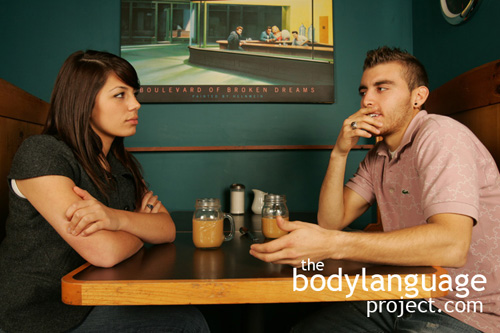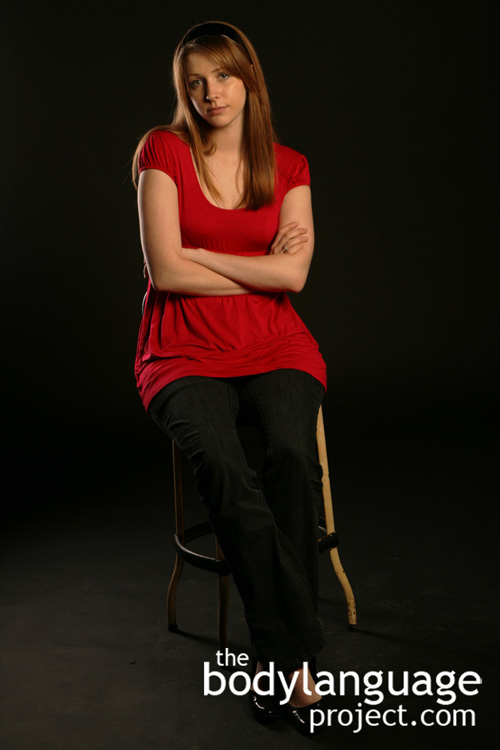Body Language of Hand Clenching or Fist Clenched
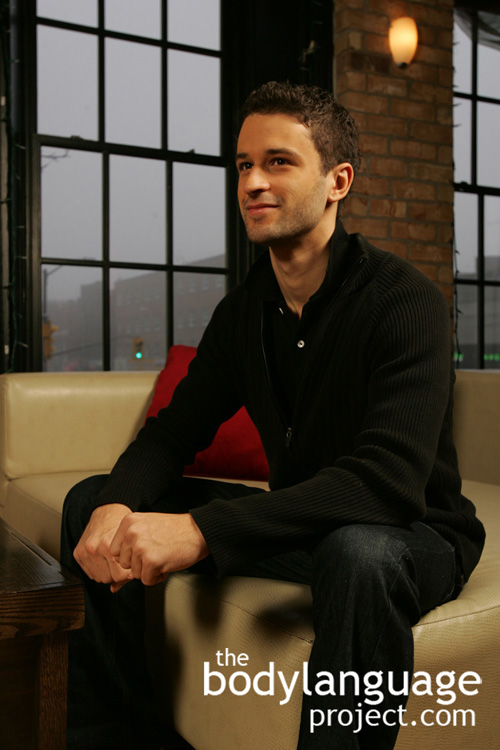 Cue: Hand Clenching or Fist Clenching
Cue: Hand Clenching or Fist Clenching
Synonym(s): Clenching and Gripping, Gripping and Clenching, Hand Wringing.
Description: A tightening, gripping, or balling, no matter how subtle or forceful, of the hands. At times the fingers may become interlaced appearing as if in prayer, which might even be the case. Pressure can be so great that the fingers can even blanch as blood flow is impeded.
In One Sentence: Clenching the hands or balling them in a fist is a sign of repressed aggression.
How To Use it: Ball and clench the fist if you wish to show others that you are resisting the urge to strike out. The gesture can be feigned as an anger-bluff in order to receive better treatment. Waving a clenched fist tells others that they should take you seriously lest you lash out with physical force.
Naturally, this nonverbal signal should be used with care as physical aggression, or even threat of physical aggression is strongly frowned upon.
Context: General.
Verbal Translation: “I really want to strike out at you due to my emotional distress which is why my hands are balling up into a fist, but instead I’m going to resist because it’s inappropriate to hit people.”
Variant: Other forms of clenching includes gripping the wrist of the opposite hand in behind the back, or wringing the hands out like a wet article of clothing, clenching the jaws tight or even talking through the teeth, cracking knuckles, pulling the hair or even plucking it, pinching one’s self, and clenching the fists by turning them into a ball are all forms of clenching and gripping.
See Interlaced Fingers, Hand Gripping Upper Arm or Wrist Behind Back.
Cue In Action: a) President Nixon was videotaped intensely balling his fist such that his knuckles turned white during a press conference called to discuss what was supposed to be a temporary incursion into Cambodia. The rest of his body was confident and his voice was smooth, yet his hands gave his restraint and dishonesty away.
b) A deadline was fast approaching when she was interrupted by her boss. She had to be polite so she couldn’t tell him to buzz off. She clenched her fists and rested them on her lap until he had finished.
c) Things didn’t start off well as the teacher rested her fist balled up on her desk knuckles down as she stood over the delinquent student. Immediately, the student showed signs of resistance by clenching her jaw. When the punishment came due, the student mirrored the balled fist of the teacher and brought it to her mouth to stifle an outburst. To show her persistent disagreement, the student rested her forearms against the table and maintained her tightly clenched fist.
Meaning and/or Motivation: Holding the fists clenched shows aggression, defensiveness, frustration, restrain, and sometimes a readiness to attack.
Hand wringing, when the hands are clasp one inside the other and tightly clamped and twisted on each other signifies high anxiety, stress or low confidence and is a pacifying behaviour. It can be done so aggressively that the fingers or knuckles turn white.
Fist clenching happens very naturally and subconsciously; a slip of the hand so to speak. Women can even be seen doing this while being verbally berated by a partner. Of course, holding a tight fist does not necessarily mean they intent to strike out, rather it shows just the opposite – that their minds are dealing with a dilemma, of which social norms prevent physical resolutions.
So very rarely are we allowed to fully express our emotions. In fact, one of the most important lessons we learn early in life is self control and this is exactly what happens when the fist is balled, clenched, but resists striking. We learn very early on that it’s not acceptable to throw fits and tantrums so we do the next best thing – we get very close to striking, but stop at the last second.
The height of the clenched fist is related to the strength of the negative mood. Hands can be clenched low on the lap or high near the face with elbows propped up on a table. If hands are clenched over the mouth, someone is probably holding back from saying something. If hands are clasped on the lap it indicates that someone is being cordial and polite, but would prefer to be doing something else – thus showing careful restraint.
Cue Cluster: Fist clenching body language is coupled with finger pointing or flared nostrils more technically termed “nasal wing dilation”, overall tensing of the body or extreme body loosening to ready for fighting, tightening of the jaw and lips (called “lip occlusion”), quivering in the lips, frowning, furrowing, or lowering the eyebrows, dilated pupils, squinting of the eyes, crotch displays such as legs open, sneering or flared nostrils.
Body Language Category: Amplifier, Aggressive body language, Anger, Clenching and gripping, Closed body language, Dislike (nonverbal), Frustration or frustrated body language, Hostile body language, Intention movements, Masked emotions, Microgestures, Negative body language, Stubborn or stubbornness, Threat displays.
Resources:
Anderson, C. A., & Bushman, B. J. (2002). Human aggression. Annual Review of
Psychology, 53, 27–51. http://dx.doi.org/10.1146/annurev.psych.53.100901.
135231.
Arsenio, W. F., Cooperman, S., & Lover, A. Affective Predictors of Preschooler’s Aggression and Peer Acceptance: Direct and Indirect Effects. Developmental Psychology. 2000. 36: 438-448.
Berkowitz, L., & Harmon-Jones, E. (2004). Toward an understanding of the determinants of anger. Emotion, 4, 107-130.
Craig, A. D. (2002). How do you feel? Interoception: The sense of the physiological condition of the body. Nature Reviews Neuroscience, 3, 655-666.
Da Gloria, Jorge ; Duda, Danièle ; Pahlavan, Farzaneh ; Bonnet, Philippe. “Weapons effect” revisited: Motor effects of the reception of aversive stimulation and exposure to pictures of firearms. Aggressive Behavior. 1989 15(4): 265-271.
DeSteno, D.; Breazeal, C.; Frank, R. H.; Pizarro, D.; Baumann, J.; Dickens, L, and Lee, J. Detecting the Trustworthiness of Novel Partners in Economic Exchange. Psychological Science. 2012. 23, 1549-1556.
http://bodylanguageproject.com/articles/use-body-language-cues-create-trust
Enquist, M. (1985). Communication during aggressive interactions with particular
reference to variation in choice of behaviors. Anim. Behav. 33, 1152-1161.
Freedman, Norbert ; Blass, Thomas ; Rifkin, Arthur ; Quitkin, Frederic Lanzetta, John T. (editor). Body movements and the verbal encoding of aggressive affect. Journal of Personality and Social Psychology. 1973. 26(1): 72-85.
Friedman, Ron and Andrew J. Elliot. The Effect Of Arm Crossing On Persistence And Performance. European Journal of Social Psychology. 2008; 38, 449–461 (2008).http://bodylanguageproject.com/articles/arm-crossing-effect-on-persistence-and-performance/
Gregersen, Tammy S. Nonverbal Cues: Clues to the Detection of Foreign Language Anxiety. Foreign Language Annals. 2005. 38(3): 388-400
http://bodylanguageproject.com/articles/what-anxious-learners-can-tell-us-about-anxious-body-language-how-to-read-nonverbal-behavior/
Hung, Iris W. and Aparna A. Labroo. From Firm Muscles to Firm Willpower: Understanding the Role of Embodied Cognition in Self-Regulation. Journal of Consumer Research. 2011 37(6): 1046-1064. http://www.jstor.org/stable/10.1086/657240
http://bodylanguageproject.com/articles/firm-muscles-lead-willpower/
Hohmann, G. and Fruth, B. (2003). Intra- and intersexual aggression by bonobos in
the context of mating. Behavior 140, 1389-1413.
Hines, N.J. and Fry, D.P. (1994) ‘Indirect Modes of Aggression among Women of Buenos Aires, Argentina’, Sex Roles 30: 213–24.
Johnson, Richard R. and Jasmine L. Aaron. Adults’ Beliefs Regarding Nonverbal Cues Predictive of Violence. Criminal Justice and Behavior. 2013. 40 (8): 881-894. DOI: 10.1177/0093854813475347.
http://bodylanguageproject.com/articles/wanna-fight-nonverbal-cues-believed-indicate-violence/?preview=true
Lagerspetz, K.M.J., Bjorkqvist, K. and Peltonen, T. (1988) ‘Is Indirect Aggression Typical of Females? Gender Differences in Aggressiveness in 11- to 12-year-old Children’, Aggressive Behavior 14: 403–14.
Marcus-Newhall A, Pedersen WC, Carlson M, Miller N. 2000. Displaced aggression is alive and well: a meta-analytic review. J Pers Soc Psychol 78:670–689.
Morgan, M. H. and Carrier, D. R. (2013). Protective buttressing of the human fist and the evolution of hominin hands. J. Exp. Biol. 216, 236-244.
Nickle, David C. and Leda M. Goncharoff. Human Fist Evolution: A Critique. J Exp Biology. 2013. 216: 2359-2360. doi: 10.1242/jeb.084871.
Navarro, Joe. 2008. What Every BODY is Saying: An Ex-FBI Agent’s Guide to Speed-Reading People. William Morrow Paperbacks.
Olson, Loreenn. ; Braithwaite, Dawno. If you hit me again, I’ll hit you back:” Conflict management strategies of individuals experiencing aggression during conflicts.
Communication Studies. 2004 55(2): 271-285.
Ostrowsky, Michael K. Are violent people more likely to have low self-esteem or high self-esteem? Aggression and Violent Behavior. 2010. 15(1): 69-75.
Pailing, Andrea ; Boon, Julian ; Egan, Vincent. Personality, the Dark Triad and violence Personality and Individual Differences. 2014. 67: 81-86.
Parker, G. A. (1974). Assessment strategy and the evolution of fighting behaviour. J.
Theor. Biol. 47, 223-243.
Rule, Nicholas, O.; Reginald B. Adams Jr.; Nalini Ambady and Jonathan B. Freeman. Perceptions Of Dominance Following Glimpses Of Faces And Bodies. Perception. 2012; 41: 687-706 doi:10.1068/p7023
http://bodylanguageproject.com/articles/people-can-read-dominance-split-second
Rizzolatti, G., Fadiga, L., Matelli, M., Bettinardi, V., Paulesu, E., Perani, D., & Fazio, F. (1996). Localization of cortical areas responsive to the observation of grasp presentations in humans by PET: 1. Observation versus execution. Experimental Brain Research, 111, 246-252.
Schubert, Thomas W. The Power In Your Hand: Gender Differences In Bodily Feedback
From Making a Fist. Society for Personality and Social Psychology. 2004. 30(6): 757-769. DOI: 10.1177/0146167204263780
http://bodylanguageproject.com/articles/men-view-power-body-language-different-women-bodily-feedback-making-fist/
Schubert, Thomas W. and Sander L. Koole. The Embodied Self: Making A Fist Enhances Men’s Power-Related Self-Conceptions. Journal of Experimental Social Psychology. 2009; 45: 828–834.
http://bodylanguageproject.com/articles/the-power-of-a-balled-fist-making-a-fist-makes-men-feel-more-powerful/
Szalai, F. and Szamado, S. (2009). Honest and cheating strategies in a simple model
of aggressive communication. Anim. Behav. 78, 949-959.
Schiff, B. B., & Lamon, M. (1994). Inducing emotion by unilateral contraction of hand muscles. Cortex, 30, 247-254.
Szamado, S. (2008). How threat displays work: species-specific fighting techniques,
weaponry and proximity risk. Anim. Behav. 76, 1455-1463.
Schubert, Thomas W. and Koole, Sander L. The embodied self: Effects of making a fist on the implicit and explicit self-concept of men and women. Journal of Experimental Social Psychology. 2009. 45: 828-834.
Tops, Mattie ; Jong, Ritske. Posing for success: Clenching a fist facilitates approach
Psychonomic Bulletin & Review. 2006, Vol.13(2): 229-234
Topel, Eva-Maria ; Lachmann, Frankm. Nonverbal Dialogues: Orienting and Looking Behaviors Between Aggressive and Violent Children and Adolescents and Their Therapist. Journal of Infant, Child, and Adolescent Psychotherapy. 2007. 6(4): 285-307.
Teixeira Fiquer, Juliana; Paulo Sérgio Boggio and Clarice Gorenstein. Talking Bodies: Nonverbal Behavior in the Assessment of Depression Severity. Journal of Affective Disorders. 2013. 150: 1114-1119.
http://bodylanguageproject.com/articles/using-nonverbal-behaviour-to-assess-depression-severity/
Underwood, M. K.. Glares of Contempt, Eye Rolls of Disgust and Turning Away to Exclude: Non-Verbal Forms of Social Aggression among Girls. Feminism & Psychology. 2004 14(3): 371-375
Young, R. W. (2003). Evolution of the human hand: the role of throwing and clubbing.
J. Anat. 202, 165-174.

